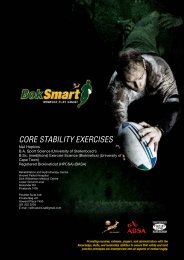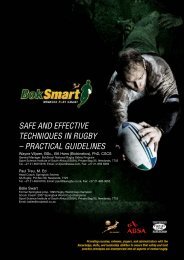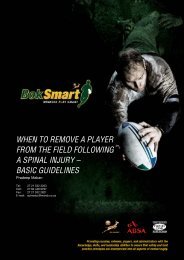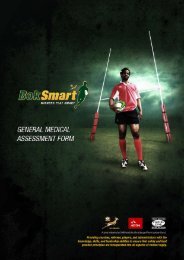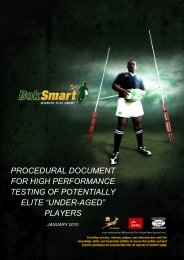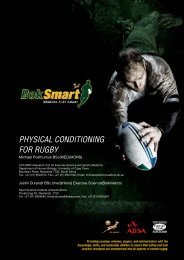FRONT PAGE HEADING PRACTICAL NUTRITION FOR ... - SA Rugby
FRONT PAGE HEADING PRACTICAL NUTRITION FOR ... - SA Rugby
FRONT PAGE HEADING PRACTICAL NUTRITION FOR ... - SA Rugby
You also want an ePaper? Increase the reach of your titles
YUMPU automatically turns print PDFs into web optimized ePapers that Google loves.
Practical Nutrition for <strong>Rugby</strong><br />
o<br />
o<br />
o<br />
the iron. Foods rich in vitamin C include tomatoes, oranges and lemons, guavas,<br />
strawberries, broccoli, and green peppers.<br />
Buy porridge and cereals that have been fortified with iron.<br />
Avoid drinking strong tea or coffee with meals since they decrease iron absorption.<br />
Remember that an iron supplement will not correct other nutritional deficiencies and can<br />
be toxic. Only take iron supplements on diagnosis of an iron deficiency and then only on<br />
the advice of a sports physician or sports dietitian.<br />
4. To improve vitamin intake:<br />
o Enjoy eating a good range of fruit and vegetables – the more colour the better. Aim for<br />
an intake of between 5-9 fruits and vegetables per day.<br />
o Boost fruit and vegetable intake by making smoothies, adding them to pizza and bread<br />
toppings and to soups and stews.<br />
o Where possible choose fresh produce, especially those in season.<br />
o Frozen vegetables are also a nutritious choice.<br />
o Use little water when cooking vegetables and avoid overcooking.<br />
INJURY AND REHABILITATION<br />
There is always a risk of getting injured when playing rugby. This may result in players missing out on<br />
training and matches for weeks or months and may also have many other consequences, which, if not<br />
addressed, can lead to a recurrent cycle of injury.<br />
Nutrition during this time is absolutely critical to promote speedy recovery. Precise nutritional<br />
considerations will vary depending on the type of injury as well the individual situation. However, a<br />
change in energy expenditure is common to all injuries and this is exaggerated if players are unable to<br />
train for long periods of time. Gaining fat mass and losing much-needed muscle mass makes<br />
rehabilitation more problematic. The additional fat gain places an extra load on the injured body part<br />
once training is resumed, placing players at more risk for further injury. Thus, central to rehabilitation is<br />
the avoidance of muscle mass loss and fat mass gain, which requires a combination of a modified eating<br />
plan and a rehabilitation training programme.<br />
16 Copyright BokSmart © 2009








